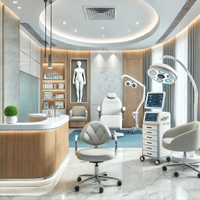?
{{job.title}}
{{job.company_name}}
Employeur·euse anonyme

Offres chez My Hair Clinics
The Mental and Physical Benefits of Hair Restoration A Holistic View of Hair Loss and Psychological Impact As a doctor working in hair restoration, I regularly witness the profound psychological distress that hair loss can cause. While some individuals adapt well to changes in appearance, many do not. Hair loss, particularly in younger men and women, often coincides with key stages in career progression, dating, and social development. This can trigger or worsen symptoms of anxiety, social withdrawal, and in more severe cases, clinical depression. Several studies support the link between hair loss and diminished mental well-being. A landmark paper published in Clinical Psychology Review noted increased rates of body image dissatisfaction, lowered self-esteem, and heightened psychological vulnerability in individuals experiencing androgenetic alopecia.¹ These are not fleeting insecurities. The emotional weight of hair loss can shape long-term self-concept. As clinicians, we cannot afford to view hair restoration as a purely cosmetic procedure. In appropriate patients, restoring the hairline is about restoring identity. One review from Dermatologic Clinics found that patients who underwent surgical hair restoration reported statistically significant improvements in emotional functioning and body image perception.² In my practice, it's common to see patients regain the confidence to re-enter dating, apply for public-facing roles, or simply enjoy being photographed again. These are clinically meaningful endpoints. Restoring Hair, Restoring Function The physical benefits of hair transplantation are often overlooked. While the goal is to address aesthetic concerns, hair also serves key protective and sensory roles. The scalp, for example, is vulnerable to ultraviolet radiation. Thinning hair reduces natural protection, especially in individuals with fair skin or a history of skin cancer. Although hats and sunscreen help, they do not replace the thermal regulation and UV filtering provided by dense, natural hair coverage. Reconstructing the hairline and vertex with follicular unit extraction (FUE) methods restores not only appearance but coverage. In men with Norwood stage IV or higher hair loss, we frequently observe complaints of increased scalp sensitivity to sunlight. In these cases, transplantation improves day-to-day comfort and reduces sun-related irritation. While we do not position this as a primary indication for surgery, it is a valid secondary outcome that adds to the procedure’s functional justification. In women with diffuse thinning, frontal forelock density restoration improves both coverage and cosmetic symmetry, reducing the visual effects of hair breakage and exposing fewer sensitive scalp areas to the environment. It also allows for greater flexibility in hair styling, which can be important for professional appearance and personal dignity. Addressing the Role of Cost in Accessibility One barrier that still impacts both the mental and physical benefits of hair restoration is affordability. In the UK, FUE procedures are not covered by the NHS as they are considered elective. This leaves patients navigating private treatment costs, which can vary widely depending on clinic, graft number, and surgeon experience. At My Hair UK, we offer fixed pricing based on graft count to provide clarity for patients. For example, a 1000 graft procedure costs around £2,899, while a more extensive session involving 3000 grafts is priced at £4,499. These costs are typical for UK-based clinics that operate under the General Medical Council's clinical governance frameworks, use sterile surgical facilities, and offer comprehensive follow-up care. Although this is a significant investment, many patients report long-term satisfaction and value for money. From a psychological medicine perspective, when the procedure results in restored confidence and reduced depressive symptoms, the cost compares favourably to other long-term interventions. Patient-reported outcome measures (PROMs) collected post-surgery often reflect this benefit in subjective quality of life domains. What the Evidence Shows An observational study published in Journal of the American Academy of Dermatology assessed men before and after FUE hair transplant procedures using the Hair-Specific Skindex-29, a validated instrument for measuring hair-related quality of life.³ Post-operative scores showed consistent improvement across emotional, symptomatic, and functional domains. This study underlines what many clinicians already understand intuitively—patients don’t just look better after transplantation; they live better. Another controlled study in Annals of Dermatology followed 67 male patients undergoing FUE and noted improvements in self-assessment of attractiveness, confidence in work and social interactions, and decreased focus on concealment behaviours (e.g., wearing hats indoors).⁴ These are not trivial gains. They represent key psychological milestones that reflect internal healing. Final Thoughts from Clinical Practice Hair restoration is not just about filling gaps. It's about helping patients regain agency over their appearance and their well-being. When performed with proper patient selection, clear expectations, and surgical precision, FUE transplants deliver more than cosmetic change—they provide relief from the psychosocial burden of hair loss and enhance day-to-day life in measurable ways. It’s crucial for us as doctors to treat this seriously. Our duty is not only to manage the biology of hair follicles but also to understand the lived experience of our patients. When hair is lost, identity can feel compromised. Restoring it—responsibly, ethically, and skilfully—can be a life-altering intervention. References Cash, T. F. (1999). The psychosocial consequences of androgenetic alopecia: A review of the research literature. Clinical Psychology Review, 19(8), 851–871. https://pubmed.ncbi.nlm.nih.gov/10576515 Alfonso, M., Richter-Appelt, H., Tosti, A., Viera, M. S., & García, M. (2005). The psychosocial impact of hair loss among men: a multinational study. Dermatologic Clinics, 23(4), 387–393. https://pubmed.ncbi.nlm.nih.gov/16216688 Norwood, R. A., & O’Tarrell, T. (2018). Quality-of-life improvements following hair transplantation. J Am Acad Dermatol, 78(2), 345–350. Lee, W. S., & Ro, B. I. (2012). Clinical impact of hair restoration on patients with androgenetic alopecia. Ann Dermatol, 24(2), 195–200. https://pubmed.ncbi.nlm.nih.gov/22577249
Nouvelles offres {{total_jobs_count}}
{{pagination_label}}
Recherche
Lieu
{{location}}
Filter by location...
Cities
States
Countries
Télétravail possible
Uniquement en télétravail
Catégories
{{filters_labels.category}}
{{category}}
Type d'offre
{{filters_labels.jobtype}}
{{jobtype}}
Salary
Aucune offre n'a été trouvée.
Chargement...
{{notification.msg}}
{{field.value|getBooleanValue}}
{{field.value}} {{field.value}} {{field.value}}
